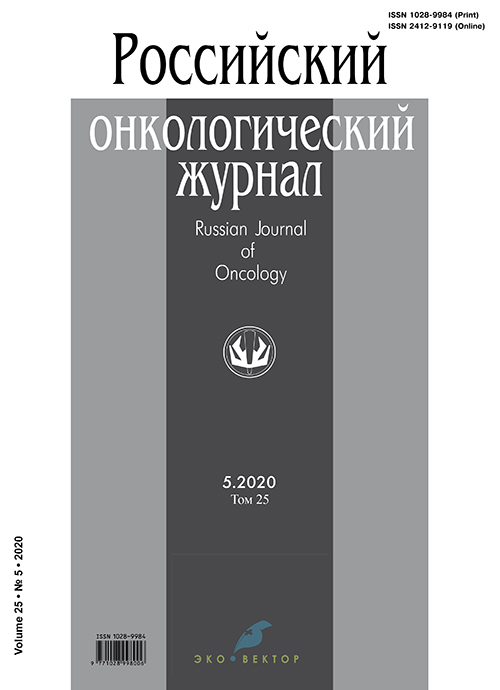Гигантская кондилома Бушке-Левенштейна
- Авторы: Меньшиков К.В.1, Липатов О.Н.1, Насырова С.Ф.1
-
Учреждения:
- ФГБОУ ВО «Башкирский государственный медицинский университет» Министерства здравоохранения Российской Федерации
- Выпуск: Том 25, № 5 (2020)
- Страницы: 181-185
- Раздел: Клинические случаи
- Статья получена: 07.05.2021
- Статья одобрена: 07.05.2021
- Статья опубликована: 14.05.2021
- URL: https://rjonco.com/1028-9984/article/view/70322
- DOI: https://doi.org/10.17816/1028-9984-2020-25-5-181-185
- ID: 70322
Цитировать
Полный текст
Аннотация
Гигантская кондилома Бушке-Левенштейна – это большое, экзофитное, медленнорастущее, доброкачественное, бородавчатое поражение аногенитальной области. Причиной данной патологии является инфицирование вирусом папилломы человека, преимущественно 6-го или 11-го типа. Патогенез гигантской остроконечной кондиломы изучен недостаточно, еë часто считают промежуточным звеном между острой кондиломой и плоскоклеточным раком. Частота встречаемости в общей популяции составляет около 0,1%, что говорит о редкости данной патологии. Гигантская кондилома Бушке-Левенштейна впервые описана авторами Buschke и Löwenstein в 1925 г. В настоящее время в литературе встречаются описания в основном единичных наблюдений пациентов с этой патологией. Основным методом лечения гигантской кондиломы Бушке-Левенштейна является хирургический, задача которого – широкое иссечение опухоли в пределах здоровых тканей. Мы приводим клиническое наблюдение 36-летней пациентки с гигантской кондиломой Бушке-Левенштейна, которой произведено хирургическое лечение – удаление опухоли промежности больших размеров. На момент операции размеры опухоли составляли 25 × 15 см. Хирургическое лечение пациентка перенесла без осложнений, заживление первичным натяжением. В течение полугода с момента операции рецидива заболевания не выявлено. Таким образом, хирургическое лечение подобных опухолей – единственный метод, позволяющий рассчитывать на излечение пациента.
Ключевые слова
Полный текст
Об авторах
Константин Викторович Меньшиков
ФГБОУ ВО «Башкирский государственный медицинский университет» Министерства здравоохранения Российской Федерации
Автор, ответственный за переписку.
Email: kmenshikov80@bk.ru
к.м.н., врач-онколог отдела химиотерапии ГАУЗ «Республиканский клинический онкологический диспансер» Министерства здравоохранения Республики Башкортостан, Россия, Республика Башкортостан, г. Уфа, пр. Октября, 73/1, 450054, доцент кафедры онкологии с курсами онкологии и патологической анатомии ФГБОУ ВО «Башкирский государственный медицинский университет» Министерства здравоохранения Российской Федерации
Россия, 450008, УфаО. Н. Липатов
ФГБОУ ВО «Башкирский государственный медицинский университет» Министерства здравоохранения Российской Федерации
Email: kmenshikov80@bk.ru
Россия, 450008, Уфа
С. Ф. Насырова
ФГБОУ ВО «Башкирский государственный медицинский университет» Министерства здравоохранения Российской Федерации
Email: kmenshikov80@bk.ru
Россия, 450008, Уфа
Список литературы
- Sandhu R., Min Z., Bhanot N. A gigantic anogenital lesion: buschke-lowenstein tumor. Case Rep Dermatol Med. 2014. 650714. doi: 10.1155/2014/650714. Epub 2014 Nov 6.
- Hicheri J., Jaber K., Dhaoui M.R., Youssef S., Bouziani A., Doss N. Giant condyloma (Buschke-Löwenstein tumor). A case report // Acta Dermatovenerol Alp Pannonica Adriat. 2006. Vol. 15, N 4. P. 181–3.
- Gürbulak E.K., Akgün İ.E., Ömeroğlu S., Öz A. Giant perianal condyloma acuminatum: Reconstruction with bilateral gluteal fasciocutaneous V-Y advancement flap // Ulus Cerrahi Derg. 2015. Vol. 31, N 3. P. 170–3. doi: 10.5152/UCD.2015.2838. eCollection 2015.
- Martin J.M., Molina I., Monteagudo C., Marti N., Lopez V., Jorda E. Buschke-Lowenstein tumor // J. Dermatol. Case Rep. 2008. Vol. 2. P. 60–2. doi: 10.3315/jdcr.2008.1019.
- Колбашова Ю.Н., Афанасьев Д.В., Философов С.Ю., Бурцев В.В. Гигантская кондилома Бушке–Левенштейна (клиническое наблюдение) // Тазовая хирургия и онкология. 2019. Т. 9, № 3. С. 54–8. doi: 10.17650/2686-9594-2019-9-3-54-58.
- Buschke A., Löwenstein L. Uber carcinomahnliche Condylomata acuminata des Penis // Berliner klinische Wochenschrift. 1925. Vol. 4. P. 1726–8.
- Fanget F., Pasquer A., Djeudji F., et al. Should the surgical management of Buschke–Löwenstein tumors be aggressive? About 10 cases // Dig Surg. 2017. Vol. 34. P. 247–52. doi: 10.1159/000452496.
- Trombetta L.J., Place R.J. Giant condyloma acuminatum of the anorectum: trends in epidemiology and management: report of a case and review of the literature // Dis Colon Rectum. 2001. Vol. 44, N 12. P. 1878–1886.
- Chu Q.D., Vezeridis M.P., Libbey N.P., Wanebo H.J. Giant condyloma acuminatum (Buschke-Löwenstein tumor) of the anorectal and perianal regions. Analysis of 42 cases // Dis Colon Rectum. 1994. Vol. 37, N 9. 950–957.
- Creasman C., Haas P.A., Fox T.A. Jr., Balazs M., Creasman C., Haas P.A., Fox T.A. Jr., Balazs M. Malignant transformation of anorectal giant condyloma acuminatum (Buschke-Löwenstein tumor) // Dis Colon Rectum. 1989. Vol. 32. P. 481–487.
- Frega A., Stentella S., Tinari A., Vecchione A., Marchionni M. Giant condyloma acuminatum or Buschke-Lowenstein tumor: review of the literature and report of three cases Treated by CO2 laser surgery. A long term followup // Anticancer Res. 2002. Vol. 22. P. 1201–1204.
- Меньшиков К.В., Пушкарев В.А., Уразин Р.Р., Пушкарев А.В. Хирургическое лечение гигантской кондиломы Бушке-Левенштейна // Медицинский вестник Башкортостана. 2018. Т. 13, № 6 (78), 8. P. 66–69.
- Indinnimeo, et al. Buschke-Löwenstein tumor with squamous cell carcinoma treated with chemo-radiation therapy and local surgical excision: report of three cases // World Journal of Surgical Oncology. 2013. Vol. 11, N 231. doi: 10.1186/1477-7819-11-231.
- Safi F., Bekdache O., Al-Salam S., Alashari M., Mazen T., El-Salhat H. Management of peri-anal giant condyloma acuminatum — a case report and literature review // Asian J Surg. 2013. Vol. 36, N 1. P. 43–52. doi: 10.1016/j.asjsur.2012.06.013.
- Trombetta L.G., Place R.J. Giant condyloma accuminatum of the anorectum: report of a case and review if the literature // Dis Colon Rectum. 2001. Vol. 44. P. 1878–1886.
- Dawson D.F., Duckworth J.K., Bernardt H. Giant condyloma and verrucous carcinoma of the genital area // Arch Pathol. 1976. Vol. 79. P. 225–231.
- Orkin B.A. Perineal reconstruction with local flaps: technique and results // Tech Coloproctol. 2013. Vol. 17. P. 663–670.
Дополнительные файлы











